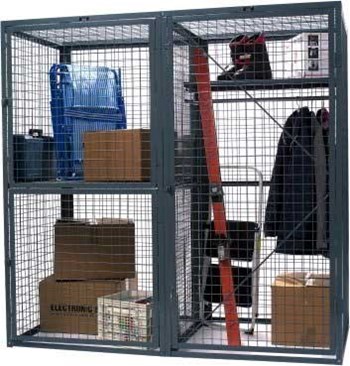
Remember in Seinfeld how you would always see Jerry’s bicycle hanging from the ceiling in the background? Perhaps if his building had had a storage room or a bike rack in the basement, this cumbersome space-saving method that many New Yorkers employ wouldn’t have been necessary.
No matter where you live, we all usually have more stuff than we know what to do with, especially in New York City, where extra space—especially for storage—is hard to come by. As a result, co-op and condo buildings are always on the lookout for creative solutions to their residents’ storage challenges and why so many are converting basement space to storage units, making hooks or racks available for bikes and adding shelves for residents to store their belongings.
Providing individual storage units to owners is an increasingly popular amenity in the city. Extra storage space can also attract buyers, and by charging residents for the use of the units, the amenity can fast become an additional revenue stream for the building.
Design Team
When a condo or co-op decides they want to add some storage space to their building, a good bet would be to call one of the companies that specialize in this service.
“Once they make the call, there’s not much else they need to do, because we design the space based on their needs,” says Al Robbins, owner of Fordham Equipment Company in the Bronx, which designs, manufactures and installs storage units and bicycle racks. “We look at the room area, determine how many people are in the building, and make a recommendation on the adequate size for their particular needs. We submit a schematic to them at no charge and give them exactly what they are looking for.”
Since the planning stage doesn’t cost the co-op or condo anything, it’s a smart decision to get estimates and space plans from a variety of companies. Most companies will do a full spec of the space and give detailed layouts of what they can do with a proposal free of cost.
“A customer or building manager can give us a call so we can set an appointment to measure the space they have in mind for the storage for no charge,” says Jerry Desir of Queens-based Giant Industrial Installations, Inc., which is the local representative and New York office for WireCrafters brand storage units. “We will give professional advice and recommendations and offer beneficial storage solutions. It will also include a layout sketch and a no-obligation proposal.”
Almost all storage units in New York are installed in unused space in the given building’s basement. When a storage company comes in, they will clean it up, waterproof the floors, enhance the lighting and do anything else needed to get the space ready for the storage units.
“We custom build on-site, so we can divide the space evenly—it doesn’t matter where we cut the steel,” says Josh Goldman of Bargold Storage Systems in Long Island City. “If there are columns or pipes in the room, we can work around those hazards.”
How many units should be built in a given building? Should the entire basement be converted, or should the space be partitioned? Ideally, everyone who wants a storage unit should be able to have one, while at the same time, none of them are vacant. To determine residents’ interest or desire for storage space, “The building will do an initial survey,” says Michael Lewis of A&D Steel, also in Long Island City.
“It’s very rare that everyone would sign up for storage,” Lewis says.
There is no hard-and-fast rule, he says, but generally, 60 percent of the apartments in a building should have storage units.
Weighing the Options
The beauty of having the storage spaces designed is that they can be made any size, but there are different options that are available depending on what the building wants.
“If the room is very damp, we recommend a storage unit in which the floor shelf is raised off the floor. If the room is dry, you don’t need that,” Robbins says. “For economy sake, we recommend the open mesh locker. It’s all open all around including the mesh top, which we recommend so no one can go and fish things out. If they are looking for complete privacy, we go and give them what we call a privacy locker. It’s an all-enclosed steel locker, like a little closet.”
Robbins says they can also install storage shelves in the spaces to more easily store books and other accessories.
“Bike racks are usually in the basement too, placed along long wall areas,” he says. “We have what is called a vertical bicycle rack to save space. More buildings are putting these in now because more and more people own bikes these days.”
Desir says that storage unit options for his company include #10 gauge wire mesh, 1-x-2-foot woven wire or 2-inch square welded wire and solid #16 gauge steel units.
“We have stock/standard sizes but can make them any custom size to satisfy your needs,” he says. “There is a three-year warranty after we install the cages that covers only manufacturer or installation defects. If the units are damaged from vandalism, then we can be called upon to inspect and repair.”
“We offer a unique solution for storage in co-op garages as well as interior areas where there may not be enough space for storage rooms,” says Gary Flyer, owner of Urbins in Riverdale. “We offer a unique wall hung metal storage cabinet that is 48-inches wide by 36-inches high by 30-inches deep.” So, if a building has a garage or an area too small for walk-in storage rooms, the building can still offer storage with these storage units, as they are wall-mounted and use unused wall space. Items that Flyer recommends storing this way include golf clubs, baby furniture, and tires.
Goldman also recommends that no matter what type of storage unit there is, you should never store anything too valuable. And never install anything dangerous that can cause liability issues for the building.
In the Beginning
For any new condos being built these days, they almost always plan to have a storage space in order to maximize the space available.
“It is one of the most requested amenities now,” says Desir. “Who wants to have a cluttered apartment or condo? We do a lot of new construction projects.”
Robbins recommends that construction companies contact them before they start building in order to figure out the best storage space solutions from the get-go.
“Any new condo being built is almost certainly going to include a storage space, and if we sit down with the engineers and contractors, we can recommend the layout that’s best for them,” he says. “This way when they build, they will have the space needed that works best.”
Goldman says that storage is often provided for the incoming residents to give them something extra.
“Most new buildings have their space pretty well allocated, so if there is a storage room it will be set up so when people move in they will have access,” he says.
Money Matters
Aside from creating some space, the storage units are also a moneymaking proposition for buildings, as residents can be charged for usage. The price is arbitrary, but most seem to be in the $50 to $100 a month range.
“In these tough times with the economy the way it is, this is a great way to produce income by taking unused space and converting it to profitable tenant storage cages or bike storage,” says Desir. “It’s a good way to build income for any basement, anywhere.”
Turning storage units into an income-generating possibility will depend on which leasing or purchasing option you choose. The average price for units sold through a manufacturer may range from $700 and up for a wire storage unit and $900 and up for a solid steel unit.
The cost to install the storage spaces varies based on the quantity and the type of material required to complete the installation, with labor and freight costs added to the price. Since all jobs are different, the price is based on what the customer asks for.
“Once the building gets that money back, the rest is all profit,” Robbins says. “It’s a great money-making investment for them.”
A company like Bargold does not charge one installation price, but instead typically installs the units and rents them out themselves at a cost usually at $65 a month in the city and $50 for Westchester and the other boroughs.
“We install for free and manage it, maintain it, bill for it, light the room and remit 25 percent of the rent back to the building,” Goldman says. “We sign up agreements with the buildings—typically for nine or 10 years—and do everything. They can either renew or ask us to leave or they can purchase the equipment when the time is up.”
According to Flyer, the sales price of each Urbins storage cabinet is $850 installed, or can be leased at $18.75 per month with a purchase option. “Urbins can generate significant income for a building via the difference between the monthly lease payment and the rent that a building charges for the storage,” Flyer says. “The amount a building charges is completely up to them.”
No matter who you go with, what material you install or how you choose to charge for them, it’s important that you look into references and even visit other buildings where the storage units have been placed to make sure you are getting what’s best for your building.
“Boards need to ask themselves if they want to be in business for themselves or not,” Goldman says. “You only go through the retrofitting of a storage space once, so you need to make a decision that will last a long time.”
Odds are, if there is storage space, it will be used. Space is tight in New York, and no one wants to throw out Aunt Agnes’ antique teapot collection, even if they do want to reduce clutter in their homes.
Keith Loria is a freelance writer and a frequent contributor toThe Cooperator.






Comments
Leave a Comment